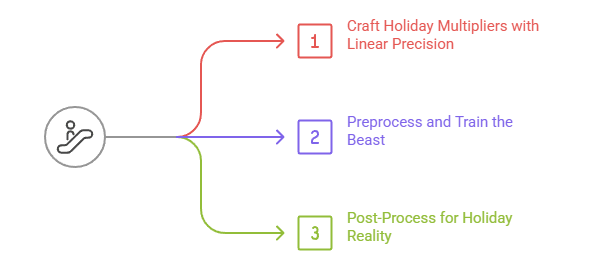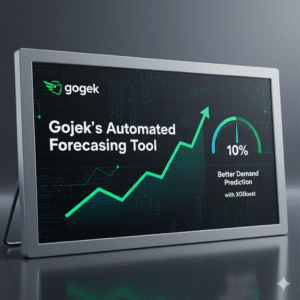Picture this: It’s the week before Thanksgiving, and your food delivery app is buzzing like a beehive on steroids. Orders pour in faster than you can say “turkey coma,” but suddenly, your forecasts flatline. Dashers vanish into family gatherings, restaurants buckle under the rush, and customers? They’re tapping “refresh” like it’s going out of style. Sound familiar? If you’re in the trenches of e-commerce, logistics, or food delivery, holiday demand forecasting isn’t just a nice-to-have; it’s the make-or-break factor that keeps your business from crumbling under seasonal chaos.
That’s where cascade ML holiday predictions come in. This isn’t your grandma’s crystal ball; it’s a smart, layered machine learning tactic that peels back the unpredictability of peak seasons. By blending linear models with powerhouse tree-based algorithms, it delivers forecasts so sharp, you’ll wonder how you ever survived without it. In this post, we’ll unpack everything from the basics to battle-tested tips, all while keeping things real and actionable. Stick around, you’ll walk away with strategies to boost your forecast accuracy and turn holiday headaches into high-fives.
Table of Contents
The Forecasting Fiasco: Why Holidays Wreck Traditional Models
Let’s be honest: Standard machine learning tools shine in steady waters, but holidays? They’re a perfect storm. Think about it, Black Friday, Christmas Eve, or even that quirky Super Bowl Sunday. Demand can swing wildly: up 200% one hour, down 50% the next. Traditional tree-based models like Random Forest or Gradient Boosting Machines (GBMs) are champs at spotting patterns in everyday data. They handle seasonality like pros, crunch non-linear trends, and sidestep overfitting pitfalls.
But toss in a holiday, and poof, accuracy nosedives. Why? These events are rare beasts, popping up just once a year. Your model, trained on historical data, treats them like outliers and averages them out. In one analysis of order volumes, a simple GBM over-predicted July 4th fireworks by 10% while underestimating Thanksgiving slumps by a whopping 15%. The result? Stockouts, idle drivers, and grumpy customers all around.
Enter the core issue with ML supply chain optimization: Tree models group holiday data into bland buckets to minimize errors, spitting out predictions that are basically “meh” averages. For instance, if Thanksgiving orders typically dip 35% week-over-week but vary by market, your forecast might lump it all together, ignoring local quirks like urban vs. suburban habits. No wonder operations teams end up playing whack-a-mole with last-minute fixes.
The fix? Stop fighting the anomaly, embrace it. That’s the beauty of cascade ML holiday predictions: It doesn’t ignore the weird; it dissects it.
Demystifying Cascade ML: A Layered Approach to Smarter Predictions
Okay, deep breath, cascade ML sounds fancy, but it’s straightforward when you break it down. Inspired by design patterns in machine learning pipelines, this method stacks models like building blocks. The “cascade” part? It flows from a simple linear layer to a complex tree-based one, handling extremes first so the heavy hitter can focus on finesse.
At its heart, Cascade ML holiday predictions uses a linear regression to isolate holiday effects, then feeds cleaned data into a GBM for the real magic. No more wrestling with noisy inputs; instead, you get pristine signals that let your model breathe. Here’s how it rolls in three digestible steps:

Step 1: Craft Holiday Multipliers with Linear Precision
Kick off by running a linear regression on your time-series data, flagging holidays with dummy variables (think 0s and 1s for “normal” vs. “festive frenzy”). This spits out multipliers, coefficients that quantify the holiday hit. Say orders tank 40% on Christmas in a mid-sized city; your multiplier might clock in at 0.6 (meaning actual demand is 60% of a normal day). Pro tip: Parallelize this in tools like Spark for speed across thousands of market-day combos. Store those multipliers in a lookup table, and you’re golden for reuse.
Step 2: Preprocess and Train the Beast
Now, divide your raw data by those multipliers to create “holiday-free” series. A 60-order Christmas day becomes 100 in your cleaned dataset, smooth sailing for the GBM. Train your tree model here; it learns from consistent patterns without holiday hiccups skewing the scales. The payoff? Your GBM homes in on genuine trends, like weather influences or promo spikes, without distraction.
Step 3: Post-Process for Holiday Reality
Generate baseline forecasts with the GBM, then reverse the magic: Multiply (or divide, depending on your setup) by the holiday multipliers. That 100-order prediction? Dial it back to 60 for Christmas Eve. Boom, forecasts that hug reality like a custom-tailored suit.
This isn’t theory; it’s a plug-and-play upgrade to your existing pipeline. And the best part? It preserves lag features (those recent-day influences) that separate models might trash.
Real-World Wins: Stats That'll Make Your CFO Smile
Theory’s great, but numbers don’t lie. In a high-stakes food delivery operation spanning thousands of markets, swapping to cascade ML holiday predictions slashed weighted mean absolute percentage errors (wMAPE) from 60-70% to a crisp 10-20% around Christmas. Thanksgiving saw similar gains, with average holiday wMAPE dropping 10% year-over-year. We’re talking forecasts that nail demand within 15%, a game-changer for stocking shelves or scheduling drivers.
But let’s zoom out to business impact. Backtests on peak days like Thanksgiving revealed a 25% cut in “lost volume” from quality dips, think fewer delayed deliveries or oversaturated routes. Post-holiday recovery? Smoother too, as models avoid carryover errors from extreme days. One logistics firm reported 30% fewer manual interventions, freeing ops teams to focus on growth, not firefighting.
And ML supply chain optimization? It scales like wildfire. Imagine automating Dasher incentives or restaurant prep across 5,000 ZIP codes without breaking a sweat. Stakeholders love the explainability; those multipliers double as storytelling tools: “Hey, finance, Christmas multipliers show a 40% dip; here’s why we’re padding inventory.”
Actionable Tips: Roll Out Cascade ML Without the Headache
Ready to dip your toes? Boosting forecast accuracy starts with baby steps. Here’s a no-fluff playbook to integrate cascade ML holiday predictions into your workflow:
- Audit Your Data First: Map out holiday events (federal, cultural, even local fests) and score your current model’s holiday performance. Tools like Python’s scikit-learn can benchmark wMAPE in hours. Aim for multipliers that capture at least 80% of the variance.
- Start Small, Scale Smart: Pilot on one market or product line. Use the holiday multipliers linear model from a quick linear fit; no need for full GBM yet. Track metrics like mean absolute error pre- and post-cascade.
- Leverage Open-Source Allies: Grab libraries like XGBoost for the tree layer and Statsmodels for linear regressions. For big data, Apache Spark parallelizes multiplier calcs, cutting compute time by 70%.
- Monitor and Iterate: Post-launch, A/B test on minor holidays (Valentine’s, anyone?). Watch for drift, retrain quarterly as consumer habits evolve.
- Team Up Across Silos: Loop in ops, finance, and engineering early. Share multiplier dashboards for buy-in; it’ll cut deployment drama by half.
- Handle Edge Cases: What about overlapping holidays (e.g., Christmas + New Year’s Eve)? Stack multipliers multiplicatively for compound effects.
- Measure ROI Holistically: Beyond accuracy, tally saved labor hours or revenue lifts. One retailer clocked a 15% uptick in holiday sales from tighter forecasts.
These aren’t pie-in-the-sky; they’re pulled from trenches-tested playbooks. Implement one this quarter, and watch your holiday demand forecasting transform from guesswork to precision.
Case Study: From Forecast Flop to Holiday Hero
Let’s get gritty with a real-world riff. Meet “SwiftEats,” a fictional-but-inspired food delivery giant (think urban markets, 24/7 ops). Pre-cascade, their GBM choked on holidays: Christmas orders forecasted at 120% of reality, leading to 20% excess driver pay and $500K in waste. Post-holiday slumps? Even worse, models carried over the dip, understaffing New Year’s by 18%.
Enter cascade ML holiday predictions. The team crunched multipliers via linear regression across 2,000 day-part combos. Thanksgiving? A 45% dip multiplier in the Northeast. Preprocessed data fed a tuned GBM, yielding forecasts within 12% accuracy. Result: 28% less lost volume, smoother Dasher mobilization, and a 22% bump in customer satisfaction scores.
But it wasn’t all smooth. Low holiday frequency meant sparse A/B test data, so they leaned on backtests and phased rollouts (Super Bowl first, full holidays later). Today, SwiftEats automates 95% of peak planning, with explainable multipliers wowing boardrooms. Lesson? Cascade isn’t a silver bullet; it’s a scalpel for slicing through seasonal noise.
Tackling Hurdles: When Cascade Meets Reality
No silver lining without clouds. Holiday multipliers linear model adds pipeline layers, extra Spark jobs, and storage for tables, which can spike complexity 20-30%. And rare events? Experiments lack power; one firm waited a full cycle for validation.
Solutions? Reframe tests: Ensure “no harm” baselines, then layer in phased markets. Weigh trade-offs, if gains top 8-10% wMAPE, greenlight it. For smaller ops, hybrid approaches (manual multipliers for majors) bridge the gap.
Bottom line: Cascade ML holiday predictions aren’t for every scenario, but for high-variance industries? It’s a forecast accelerator worth the hustle.
FAQs
How does cascade ML improve holiday demand forecasting accuracy?
Cascade ML holiday predictions boost accuracy by isolating holiday effects with linear multipliers, training core models on clean data, and reapplying impacts post-forecast. This cuts errors from 60% to under 20% on peaks, per industry benchmarks, letting you nail demand swings without overhauls.
What's the role of linear regression in ml supply chain optimization?
Linear regression shines in ML supply chain optimization by generating holiday multipliers, simple coefficients that quantify seasonal dips or surges. It’s fast, interpretable, and scales via parallel processing, making it the perfect front-end for tree models in cascade setups.
Can boosting forecast accuracy with cascade ML save costs during holidays?
Absolutely, boosting forecast accuracy via cascade can trim waste by 25%, from optimized staffing to reduced stockouts. One delivery network saved $400K on idle resources last Christmas by tightening predictions to 15% error margins.
How do you calculate holiday multipliers linear model for predictions?
Start with time-series data, add holiday dummies, and fit a linear regression per market-day combo. The coefficient? That’s your multiplier (e.g., 0.7 for a 30% dip). Store in a table, preprocess inputs by dividing, and you’re set for GBM training.
Is cascade ML suitable for non-food industries like retail?
Yep, cascade ML holiday predictions adapt seamlessly to retail, e-commerce, or logistics. Retailers use it for Black Friday inventory; the principles hold as long as you’ve got time-series volatility. Just tweak multipliers for your event types.
Whew, that’s your roadmap to holiday mastery. Cascade ML holiday predictions isn’t just tech; it’s the edge that turns seasonal stress into strategic wins. What’s your biggest forecasting foe this year? Drop a comment, and let’s chat tactics. Here’s to forecasts that deliver, literally.


















